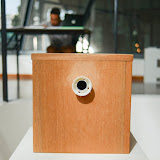At best, eclectic
 |
| The Artists Village Show (2013) |
The Artists Village had never quite been pinned to a specific style or agenda. The recent group show might just endorse this view. It might disappoint the ardent art buff because it resembles a degree show in terms of scale, derivative ideas, style, taste, artistic methodology, media or technical completeness. In contrast to that, a fan of the Artists Village might be intrigued by the fluidity, flux of new ideas and media, and how these interlace and influence contemporary artists living and working in Singapore. The Artists Village is perhaps one of the best cases to understand Singapore Art and the ground issues faced by practitioners in Singapore. With sufficient grit, a would-be Singapore Art historian might find enough material to write a substantive tome from the Artists Village archives to shed light on individuals, and collectives that operate loosely within Singapore’s contexts. Yet this phoenix-like organisation also has the historical burden to constantly surprise and continue to make history. Like any other organisations in the 21st century, not just art groups, the Artists Village faces challenges from within and outside: Evolving leadership and membership; issues of competition, support, relevancy, and obsolesce in the face of new media.
The motivation behind the exhibition began with the inward thinking, exploration and interpretations of the word ‘show’. This could have been further exploited if the exhibition’s title, site, display and texts could have been pushed further. Not in the gimmicky sense, but in a thoughtful and meaningful manner.
The exhibition title might be described as lacklustre, just the same it sums up what the show is about. The curatorial slant might have stirred more dialogue and debate if it did engage with notions about and surrounding degree shows and how they relate to the ‘art world’. It might be the lack of lead-time, or remiss of communication between the curators and artists, the curatorial dimension failed to resonate the potential dialogue between the artists and artworks, or harness the power of collectives or utilise the art institution site to its full potential. The use of wall texts would then play a more important role to highlight the curatorial intent, supporting the individual artist’s intent or collective statement, perhaps.
In sum, the show might best be described as varied, not in the miscellaneous sense, but in a misdirected sense. Having typed that, it doesn’t mean that individual works failed to deliver the brief. Notably, Cheng Guangfeng’s Show tune: irritability (2013) is quite a buzz. It nails what the art world might appear to the uninitiated, or how art, or beauty, is to the eye of the beholder. An unassuming wooden box sits on a plinth, an irritable familiar fly buzzing sound emanates from the box. The box resembles both a prototype speaker, a humble means to transmit a sound, tune or voice. The box also resembles a light bulb holder, ready to be used as a prop for something perfectly banal and ordinary. Instead of just seeing the artwork, the viewer has to make sense of all this through hearing and quite bit of imagination and interpretation. As I write this, I am humbled by Chen’s artwork again. The ambiguity and simplicity of the work truly invites us to ponder what the arts are all about, and why they must be experienced in person then merely reading about it. The arts have the potential to inspire, inform, educate and in some instances entertain. Besides depending on the curator and artists to do all these, and surely not equally on all fronts, the viewer can take pride and initiative to make meaning too.
Institute of Contemporary Arts Singapore (ICAS) (specifically Project Space and Praxis Space, Blocks G and H, Level 1, G101, H101) LASALLE College of the Arts.
28 Nov – 10 Dec 2013.
The Artists Village website: http://www.tav.org.sg/
Read another review by Helmi Yusof here: What’s become of the Artist Village? (BT, 2013)
To search for other formally registered art societies in Singapore, or for information on Singapore’s Registry of Societies, see: http://www.ros.gov.sg
